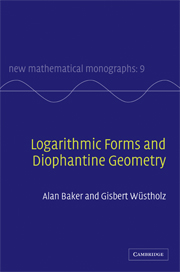8 - Further aspects of Diophantine geometry
Published online by Cambridge University Press: 10 November 2009
Summary
Introduction
There is a clear division in mathematics between results that one terms ‘effective’ and others that one terms ‘ineffective’. Most of the material discussed so far in this book relates to the theory of logarithmic forms and this is certainly effective. The typical case is an application to a Diophantine equation and here the theory leads in general to an explicit bound for all the integer variables, whence the complete solution can be determined in principle (and often in practice) by a finite amount of computation. There is however a substantial body of work in Diophantine geometry and elsewhere which enables one to decide whether there are finitely or infinitely many solutions to a particular problem, and indeed in general to give an estimate for the number of solutions when finite, but which cannot in principle lead to a complete determination. It is consequently termed ‘ineffective’. Some famous instances here are the Schmidt subspace theorem, Faltings'theorem on the Mordell conjecture and Siegel's theorem on the class number of imaginary quadratic fields. Historically these have been important in the overall evolution of mathematics and to conclude our book we give a short discussion of some of these topics.
The Schmidt subspace theorem
In 1972 W. M. Schmidt [209] (see also [210]) obtained a far-reaching generalisation of the Thue–Siegel–Roth theorem, that is Theorem 1.7, relating to simultaneous Diophantine approximation.
- Type
- Chapter
- Information
- Logarithmic Forms and Diophantine Geometry , pp. 167 - 177Publisher: Cambridge University PressPrint publication year: 2008



